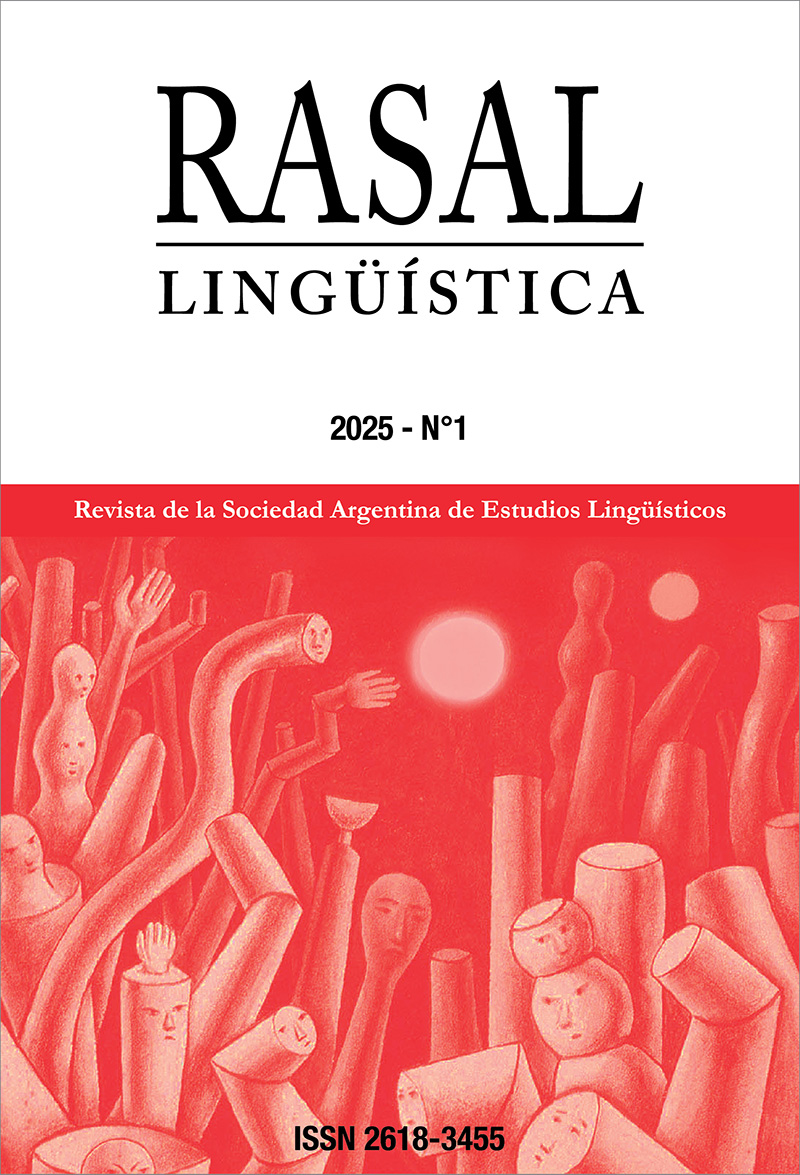Metaphoremes, semantic neologicity and lexicographic representation
DOI:
https://doi.org/10.56683/rs251139Keywords:
metaphoreme, semantic neologisms, norms and exploitations, dictionarizationAbstract
This article approaches semantic neology by articulating the notion of metaphoreme (Cameron & Deignan, 2006), the Theory of Norms and Exploitations (Hanks, 2013) and the concept of neologicity, i.e. a process of change, in various stages and dimensions, that neologisms go through (Freixa, 2022), based on the model case of the Spanish semantic neologism habitar. The corpus-based analysis of these categories allows us to establish which stage of the neological process the different uses of this neologism are in, since it provides criteria to identify linguistic, conceptual and pragmatic restrictions, which in terms of the neological process are articulated with the linguistic, cognitive and social levels. Based on the description in corpus of the uses of habitar, the stability they exhibit and the stages they occupy in the neological process, which impact –or should impact– on their dictionarization, a critical analysis of the representation of the metaphorical senses of this word in six general Spanish dictionaries is offered.
Downloads
References
Adelstein, A. (2019). Hacia una definición de neologicidad en semántica. En M.L. Perassi y M. Tapia (Eds.), Palabras como puentes. Estudios lexicológicos, lexicográficos y terminológicos desde el Cono Sur (pp. 209-230). Editorial Buena Vista.
Adelstein, A. (2022). Neología y semántica: grados de neologicidad en el ámbito nominal. En E. Bernal, J. Freixa y S. Torner (Eds.), La neología del español. Del uso al diccionario (pp. 361-371). Editorial Vervuert.
Adelstein, A. y Freixa J. (28-30 de octubre 2013). Criterios para la actualización lexicográfica a partir de datos de observatorios de neología. [Comunicación] Congreso Internacional “El diccionario: neología, lenguaje de especialidad, computación”, Ciudad de México, México. https://repositori.upf.edu/handle/10230/34891.
Adelstein, A., Berri, M. y Boschiroli, V. de los A. (2021). Los diccionarios: la representación y el léxico. En G. Ciapuscio y A. Adelstein (Coords.) La lingüística. Una introducción a sus principales preguntas (pp. 189-199). EUDEBA.
Berri, M. y Boschiroli, V. de los A. (2023). Neologicidad metafórica y grados de inestabilidad. En P. C. Hernández y M. G. Galvani Gelusini (Eds.), Estudios SAEL 2023 (pp. 75-88). Editorial Humanitas.
Berri, M. y Boschiroli, V. de los A. (2024). La neología semántica de los verbos: criterios estructurales para determinar grados de neologicidad. Annali del Dipartimento di Studi Letterari, Linguistici e Comparati. Sezione romanza, 66(1). 31-48.
Battaner Arias, P. (2010). La marca figurado como marca de uso. En E. Bernal, S. Torner y J. DeCesaris (Eds.), Estudis de lexicografía 2003-2005 (pp. 39-60). Institut Universitaria de Lingüística Aplicada.
Bouzidi, B. (2010). Néologicité et temporalité dans le processus néologique. Algérie, 9. 27–36.
Cameron, L. y Deignan, A. (2006). The emergence of metaphor in discourse. Applied linguistics, 27 (4). 671-690.
Cañete, P. y Freixa, J. (2014). Filtros de neologicidad e inclusión lexicográfica. En B. Camus (Ed.), Morfología y diccionarios (pp. 9-18). Universidade da Coruña.
Deignan, A. (2005).Metaphor and corpus linguistics. John Benjamins Publishing.
Freixa, J. (2022). El proceso neológico. En E. Bernal, J. Freixa y S. Torner (Eds.),La neología del español. Del uso al diccionario (pp. 51-72). Editorial Vervuert.
Freixa, J. y Monterrubio, J. M. (2022). Neologicidad y diccionariabilidad: análisis de los neologismos conciber-. En E. Bernal, J. Freixa y S. Torner (Eds.),La neología del español. Del uso al diccionario (pp. 361-371). Editorial Vervuert.
Halliday, M.A.K y Hasan, R. (1989).Language, Context and Text: Aspects of Language in a Social Semiotic Perspective. (2nd ed.). Oxford University Press.
Hanks, Patrick. (2013). Lexical Analysis. Norms and exploitations. The MIT Press.
Heidegger, M. (1951). Construir, habitar, pensar. (Trad. J. A. Escudero) Oficina de Arte y Ediciones.
Jezek, E. y Hanks, P. (2010). What lexical sets tell us about conceptual categories. Lexis, 4. 7-22.
Lakoff, G. y Johnson, M. (1999). Philosophy in the flesh: The cognitive unconscious and the embodied mind: How the embodied mind creates philosophy. Basic Books.
Lara, L. F. (1990). Dimensiones de la lexicografía: a propósito del Diccionario del español de México. Fondo de Cultura Económica.
Martínez Gajardo, C. (2011). Revisión crítico-bibliográfica en torno a la marca fig. en diccionarios de uso del español. Boletín de filología, 46(2). 219-234.
Sablayrolles, J. F. (2006). La neologie aujourd’hui. En C. Gruaz (Ed.), À la recherche du mot: de la langue au discours (pp. 141-147). Éditions Lambert-Lucas.
Santamaría Pérez, I. (2013). La representación de la resemantización en los diccionarios del español. Revista de Lexicografía, 19. 139-166.
Schmid, H. J. (2008). New words in the mind: Concept-formation and entrenchment of neologisms, Anglia, 126. 1-36.
Published
How to Cite
Issue
Section
License
Copyright (c) 2025 Marina Berri, Victoria de los Ángeles Boschiroli

This work is licensed under a Creative Commons Attribution-NonCommercial 4.0 International License.
RASAL © Algunos derechos reservados










